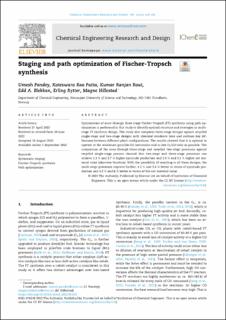| dc.contributor.author | Pandey, Umesh | |
| dc.contributor.author | Putta, Koteswara Rao | |
| dc.contributor.author | Rout, Kumar Ranjan | |
| dc.contributor.author | Blekkan, Edd Anders | |
| dc.contributor.author | Rytter, Erling | |
| dc.contributor.author | Hillestad, Magne | |
| dc.date.accessioned | 2023-02-27T12:16:43Z | |
| dc.date.available | 2023-02-27T12:16:43Z | |
| dc.date.created | 2022-09-29T16:41:20Z | |
| dc.date.issued | 2022 | |
| dc.identifier.citation | Chemical engineering research & design. 2022, 187 276-289. | en_US |
| dc.identifier.issn | 0263-8762 | |
| dc.identifier.uri | https://hdl.handle.net/11250/3054226 | |
| dc.description.abstract | Optimization of once-through three-stage Fischer-Tropsch (FT) synthesis using path optimization is performed in this study to identify optimal structure and strategies in multi-stage FT synthesis design. The study also compares three-stage designs against recycled single-stage and two-stage designs with identical residence time and outlines key differences between different plant configurations. The results showed that it is optimal to operate at the maximum possible CO conversion and as low H2/CO ratio as possible. The comparison of the once-through three-stage and recycled two-stage processes against recycled single-stage process showed that two-stage and three-stage processes can achieve 2.3 % and 2.7 % higher syncrude production and 2.8 % and 3.2 % higher net material value (objective function). With the possibility of recycling in all three designs, the multi-stage processes improve further: 4.2 % and 5.3 % better in terms of syncrude production and 4.2 % and 6 % better in terms of the net material value. | en_US |
| dc.language.iso | eng | en_US |
| dc.publisher | Elsevier B. V. | en_US |
| dc.rights | Navngivelse 4.0 Internasjonal | * |
| dc.rights.uri | http://creativecommons.org/licenses/by/4.0/deed.no | * |
| dc.title | Staging and path optimization of Fischer-Tropsch synthesis | en_US |
| dc.title.alternative | Staging and path optimization of Fischer-Tropsch synthesis | en_US |
| dc.type | Peer reviewed | en_US |
| dc.type | Journal article | en_US |
| dc.description.version | publishedVersion | en_US |
| dc.source.pagenumber | 276-289 | en_US |
| dc.source.volume | 187 | en_US |
| dc.source.journal | Chemical engineering research & design | en_US |
| dc.identifier.doi | 10.1016/j.cherd.2022.08.033 | |
| dc.identifier.cristin | 2056923 | |
| cristin.ispublished | true | |
| cristin.fulltext | original | |
| cristin.qualitycode | 1 | |

